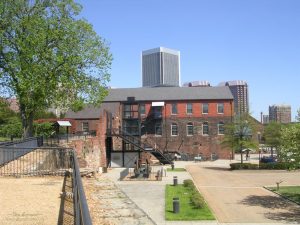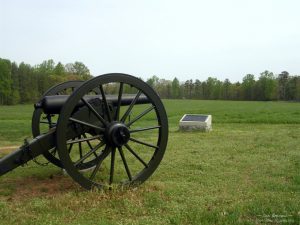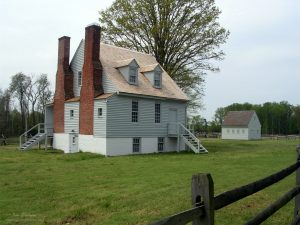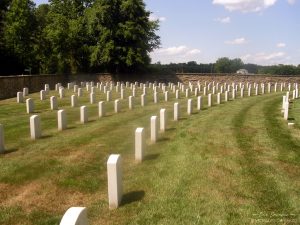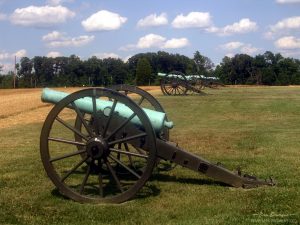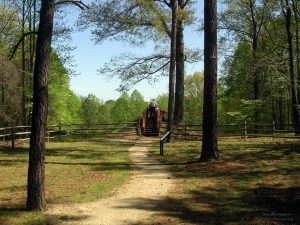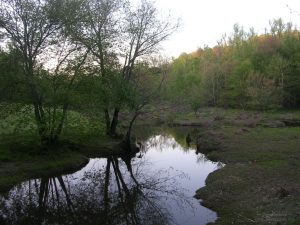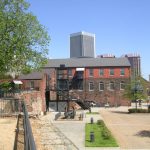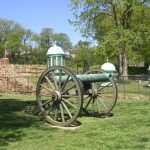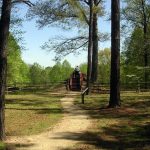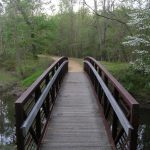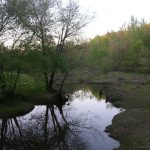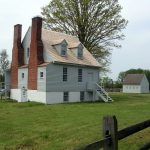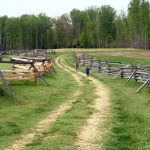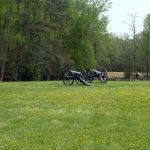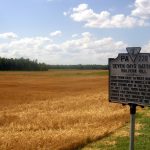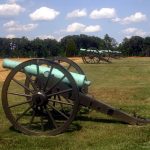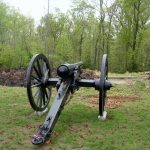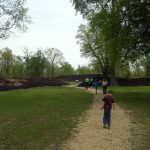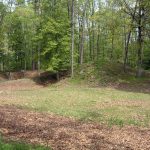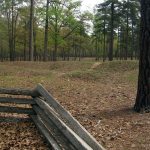
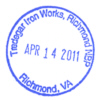 Richmond National Battlefield Park, Virginia, consists of several units in and around Richmond, Virginia which protect the locations of key Civil War battles and defensive positions which protected the Confederate capitol of Richmond in two campaigns in 1862 and 1864. The park is also home to the historic Tredegar Iron Works, a civil war-era hospital and four national cemeteries.
Richmond National Battlefield Park, Virginia, consists of several units in and around Richmond, Virginia which protect the locations of key Civil War battles and defensive positions which protected the Confederate capitol of Richmond in two campaigns in 1862 and 1864. The park is also home to the historic Tredegar Iron Works, a civil war-era hospital and four national cemeteries.
Visitor Rating (write your own review below)
ILNP Park Review
 Our Visit. My family and I visited Richmond NBP twice, once in June and once in April during a visit to see family in the area.
Our Visit. My family and I visited Richmond NBP twice, once in June and once in April during a visit to see family in the area.
Our Weather. In June, it was partly cloudy and humid with a temperature in the upper 80s. In April, it was sometimes sunny, sometimes overcast and lower 70s.
Overall Impression. Richmond NBP is not flashy like a lot of other parks. In fact, unless you’re looking for it, you’d probably drive right by. If you are looking, though, you will see hundreds of historical markers detailing the numerous battles and events surrounding Richmond during the Civil War. Because so much has grown up in this area over the past 150 years, you have to use a little imagination to see what it must have been like for the tens of thousands of Union and Confederate troops that fought and died here, but the NPS has done a good job of telling the story here with maps, trails, signs and displays throughout several pieces of historic property around Richmond. This park is a wonderland for a Civil War enthusiast, but even those who are not can get a glimpse into the history that surrounded one of the most strategic cities during the Civil War.
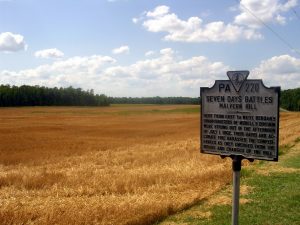
Markers such as this one dot the landscape and give brief descriptions of action around Richmond. This one marks Malvern Hill where Union forces held off waves of Confederate charges with well-placed artillery (June)
Visiting. Visiting Richmond NBP is challenging because it is so spread out. The NPS recommended driving loop is 80 miles long, so unless you have at least a full day, sunrise to sunset, set aside, you will only see parts of it. Which parts to see depends on your interests. If you’re only driving through Richmond, you’ll probably find one or two units of the park along your route. If you’re going to spend some time in Richmond, I recommend you do some research beforehand to plot your route through the park. Tredegar Iron Works in downtown Richmond is a good place to start for any visit as it contains a visitors center and general information on the battles around Richmond. If you’re more interested in period history than battles, a visit to Tredegar and Chimborazo Medical Museum, also downtown, will probably satisfy your curiosity. If you’re more interested in Civil War history, a visit to Cold Harbor and Gaines Mill and perhaps Malvern Hill will be the most rewarding. If you want to see the best preserved earthworks and forts in the area, then Fort
Harrison is where you want to go. If I had to rank areas to visit, I would pick Cold Harbor-Gaines’ Mill, Tredegar Iron Works, Fort Harrison and Glendale-Malvern Hill, in that order. Below are more specifics on each area to help you chart your own course.
Tredegar Iron Works
Tredegar Iron Works was one of the most significant iron manufacturing mills during the Civil War and provided the Confederacy with thousands of cannons and even iron sheeting for the famous ironclad CSS Virginia. Preserved within the Tredegar complex are several examples of machinery and products, remnants of the Kanawha Canal, and a small museum on the upper level compliments the information you can get at the visitor center on the main level. Tredegar also has a 20-minute video explaining more about the battles around Richmond. The Tredegar campus is also home to the American Civil War Center (separate admission). Budget 60-120 minutes to visit.
Chimborazo Medical Museum
The Chimborazo Medical Museum is located on the grounds of what was once one of the largest military hospitals of the Civil War. Within the museum are original medical instruments and artifacts from the war. (I did not visit this section of the park)
Cold Harbor Battlefield and Visitor Center
Cold Harbor was the site of a decisive battle in General Grant’s 1864 Overland Campaign. In this battle, the Confederates inflicted massive casualties and turned back the Union advance on Richmond. This area of the park is a good one for visitors wishing to drive through a battlefield. A one-mile loop takes visitors through some of the Confederate and Union earthworks (berms and trenches) from the battle. Be sure to stop by the Cold Harbor Visitor Center first and view the excellent map of both the Cold Harbor and earlier Gaines’ Mill battles animated by hundreds of colored lights to tell the story of these battles. Budget 30-90 minutes to visit.
Gaines’ Mill
Gaines’ Mill was the site of the heaviest casualties of the 1862 Seven Days Battles. It was here where Confederate troops broke through Union lines and forced a withdrawal south toward Malvern Hill. The road into Gaines’ Mill offers easy access to the Watt House, a building which survived the battle, and the battlefield. A one-mile trail around the field offers views and signs with information about the pieces of the battle, but even a short jaunt onto the field gives a good impression of the terrain and lines of the battle. Be sure to view the animated map in the Cold Harbor Visitor Center before coming to Gaines’ Mill. Budget 15-75 minutes to visit.
Glendale
Glendale was part of the 1862 Seven Days Battles and marks the site where Union forces protected a critical crossroads from Confederate attacks long enough for General McClellan’s army to withdraw from their defeat at Gaines’ Mill. Glendale is home to the Glendale-Malvern Hill Visitor Center and the Glendale National Cemetery. A light-animated map in the visitor center is helpful for understanding the movement of the battle at Glendale and Malvern Hill. Budget 20-45 minutes to visit.
Malvern Hill
The battle of Malvern Hill was one of the few Union victories around Richmond and marked the end of the Seven Days Battles in 1862. Here, Union forces amassed a defensive line which repelled several waves of attacking Confederates allowing McClellan an orderly withdrawal from Richmond. The current battlefield at Malvern Hill has been restored close to how it appeared in 1862. Cannons mark the positions of the Union and Confederate lines, and a marked trail and signs outline different facets of the battle. Budget 15-60 minutes to visit.

Trail through the earthworks at Fort Harrison. The berms have recently been burned to keep the grass and weeds in check (April)
Fort Harrison
Fort Harrison and surrounding forts were the southern part of the Confederate’s exterior defensive line which nearly surrounded Richmond. Several forts including Fort Gilmer, Fort Gregg, Fort Johnson, Fort Harrison, Fort Hoke and the Union’s Fort Brady are contained within this section of the park. Fort Harrison was captured by Union forces in 1864, rebuilt into a circle and renamed Fort Burnham. Fort Harrison/Fort Burnham is the best preserved of the forts, and a short walking trail gives visitors access to the earthworks. This is the best preserved and most accessible set of earthworks in Richmond NBP. Budget 30-90 minutes to visit.
Drewry’s Bluff
Drewry’s Bluff, known to Union forces as Fort Darling, was responsible for defending Richmond from attack via the James River. In May 1862, the defenders at Drewry’s Bluff attacked a small fleet of Union ships, including the ironclad USS Monitor and successfully repeled the attack. This was also the home of the Confederate Naval Academy and Marine Corps camp. The current site consists of a walking trail with displays and overlooks of the James River (I did not visit this section of the park).
Chickahominy Bluff
Chickahominy Bluff overlooked the Chickahominy River. From this vantage point, the Confederates watched McClellan’s Union army prepare for an assault on Richmond. Rather than wait for the attack, General Lee ordered his own attack near Beaver Dam Creek. He watched his forces under the command of General “Stonewall” Jackson make the first attack of the Seven Days Battles from this bluff. The current site consists of a very short path past some Confederate earthworks to an overlook. Sadly, the overgrown woods obscure the view, so one can only imagine what General Lee must have seen. Budget 15 minutes to visit.
Beaver Dam Creek
Beaver Dam Creek was the site of the first Confederate attacks of the Seven Days Battle. While unsuccessful, the attacks caused General McClellan to withdraw the Union forces toward Gaines’ Mill where the most bitter fighting would occur. The current site preserves a small section of the front, but there is little to identify it as a battleground. A short path crosses a bridge over Beaver Dam Creek to a few signs describing the battle. I visited near sunset and discovered this to be a good area for seeing wildlife. I saw a great blue heron fishing in the creek and even saw a beaver paddle by–no kidding! Budget 15 minutes to visit.
Parker’s Battery
Parker’s Battery was part of the “Howlett Line” built by the Confederates to help contain Union forces on the Bermuda Hundred peninsula. The current site consists of a short walking trail through the woods that contain the earthworks for this part of the line (I did not visit this section of the park).
Suggestions. This park is quite spread out, and some of the areas are fairly obscure. Signs can be difficult to find, especially if you’re not taking the main route to that section of the park. Bottom line–a good map of Richmond or a GPS is a must.
Nearby Towns Richmond (Virginia)
Other Nearby Attractions Petersburg National Battlefield, the American Civil War Center
Official NPS Website Richmond NBP
- Tredegar Iron Works is home to a small museum covering both the iron works themselves and the battles around Richmond
- Tredegar Iron Works with downtown Richmond in the background (April)
- The grounds at Tredegar are loaded with displays and monuments such as this one to Abraham Lincoln (April)
- Typical Civil War cannon at the Tredegar Iron Works similar to the thousands built here during the Civil War (April)
- The short path to the overlook at Chickahominy Bluff (April)
- The bridge over Beaver Dam Creek connects to a short trail (April)
- Slow waters of Beaver Dam Creek at sunset. Can you spot the great blue heron (April)
- Watt House at Gaines’ Mill Battlefield (April)
- Road leading through the battlefield at Gaines’ Mill (April)
- Cannons on the field at Gaines’ Mill (April)
- Glendale National Cemetery (June)
- Markers such as this one dot the landscape and give brief descriptions of action around Richmond. This one marks Malvern Hill where Union forces held off waves of Confederate charges with well-placed artillery (June)
- Union cannon sit atop Malvern Hill (June)
- The Malvern Hill visitors center explains the nearby battles using this nifty 3D map. The lines of colored lights move and flash along with the audio commentary to give visitors a better feel for the battles (June)
- Blooming dogwoods along the open area next to Fort Harrison (April)
- A cannon along the walking trail at Fort Harrison. Some of the fort’s earthworks were added after Union forces overran Fort Harrison and renamed it Fort Burnham. The black is the results of recent weed control efforts (April)
- Trail through the earthworks at Fort Harrison. The berms have recently been burned to keep the grass and weeds in check (April)
- Fort Gilmer is one of the forts preserved within the Fort Harrison section of the park (April)
- Confederate earthworks along the road at Cold Harbor Battlefield (April)
- Cannon overlooking the battlefield at the Cold Harbor Visitor Center (April)
Write Your Own Review

